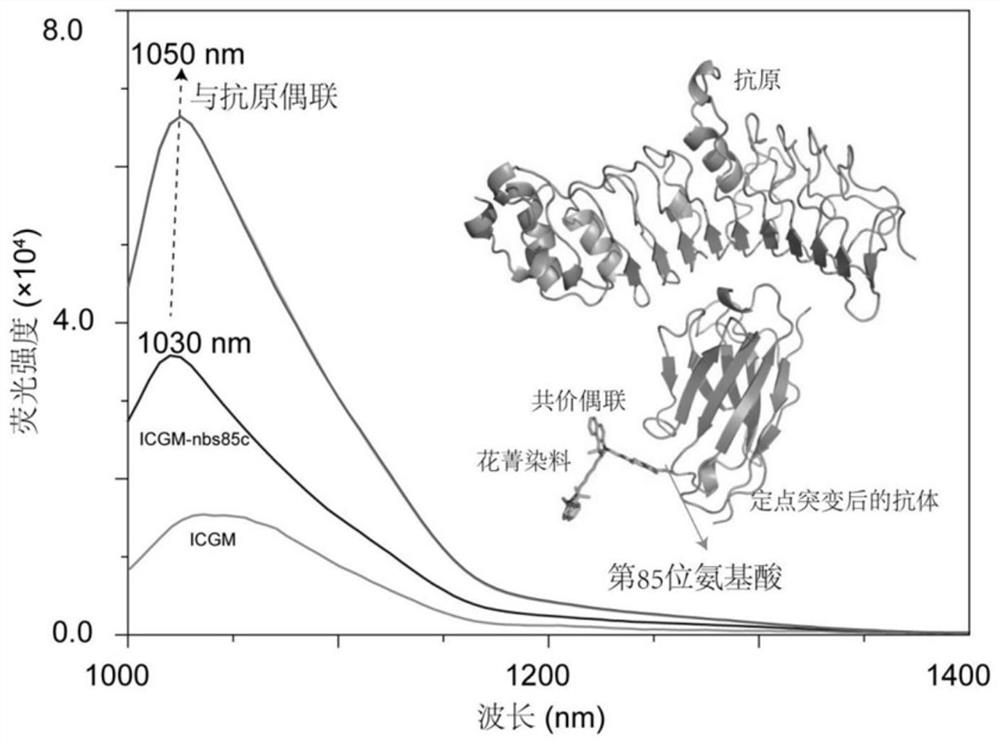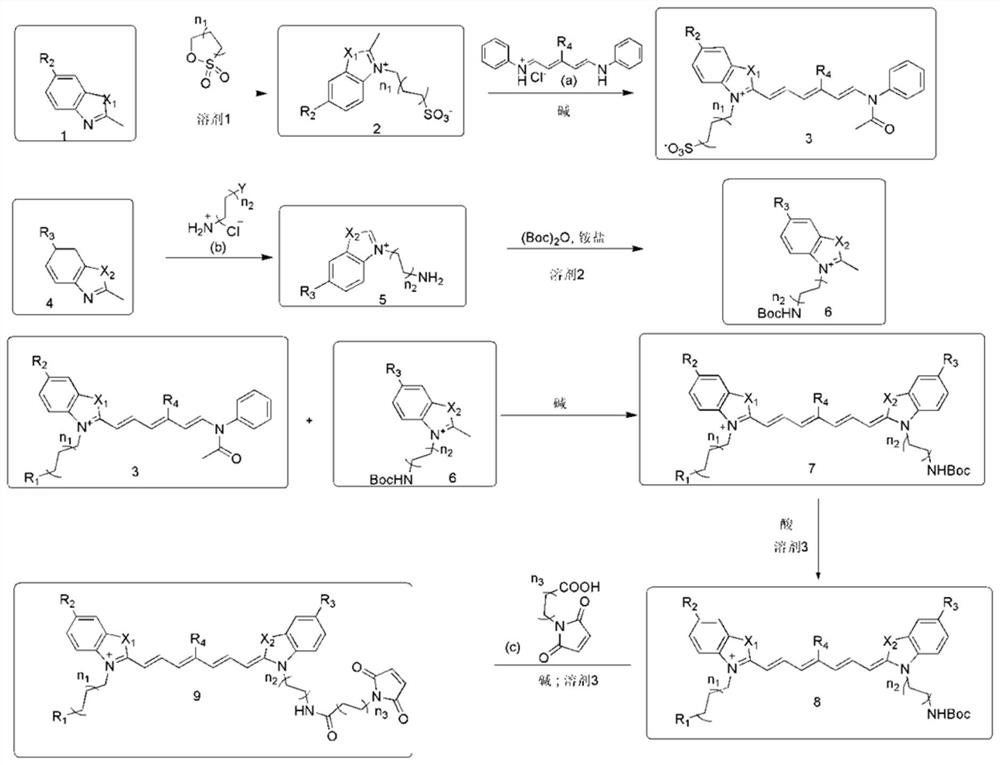Near-infrared two-window fluorescence immunoprobe as well as preparation method and application thereof
A fluorescence immune and near-infrared technology, applied in the field of fluorescence imaging, can solve the problems of complex composition and poor stability, and achieve the effects of low light scattering, low cost and low dosage.
- Summary
- Abstract
- Description
- Claims
- Application Information
AI Technical Summary
Problems solved by technology
Method used
Image
Examples
Embodiment 1
[0086] The preparation method of a typical near-infrared fluorescent dye is as follows: image 3 shown, including the following steps:
[0087] (1) Preparation of intermediate (2)
[0088] Dissolve compound (1) in solvent 1 (toluene, benzene, dimethyl sulfoxide, N,N-dimethylformamide or N,N-dimethylacetamide, etc.), add dropwise In the eggplant-shaped bottle of lactone, the reaction temperature is 40-120° C. (preferably 110° C.), and the reaction time is preferably 2 hours to obtain the intermediate (2).
[0089] (2) Preparation of intermediate (3)
[0090] Dissolve the intermediate (a) and base in the solvent, add them in batches to the eggplant-shaped bottle containing the intermediate (2) and stir, the reaction temperature is 40-90°C (preferably 80°C), and the reaction time is preferably 60 minutes , to obtain intermediate (3). The base is selected from various organic bases or inorganic bases, preferably sodium carbonate, sodium bicarbonate, potassium carbonate, potass...
Embodiment 2
[0102] Preparation of conjugates of near-infrared fluorescent dyes and single-domain antibodies figure 2 The steps shown are carried out as follows:
[0103] (1) After the single domain antibody and the reducing agent are mixed, shake and react for a period of time, the near-infrared fluorescent dye is dissolved in an organic solvent, and added to the mixed solution containing the antibody and the reducing agent in batches to obtain a mixture. The reducing agent used to break the disulfide bonds of the antibody is selected from various organic and inorganic reducing agents, preferably tris(2-chloroethyl)phosphate, diethyltriaminepentaacetic acid, 5,5'-dithiobis (2-nitrobenzoic acid). The organic solvent is selected from N,N-dimethylformamide, N,N-dimethylacetamide, dimethyl sulfoxide, etc., the reaction temperature is 4-60°C, preferably 37°C, and the reaction time is preferably 60 minutes.
[0104] (2) Add the mixture obtained in step (1) to the desalting column. Collect f...
Embodiment 3
[0106] A kind of preparation of near-infrared fluorescent dye ICGM according to Figure 4 The steps shown are carried out as follows:
[0107] (1) Preparation of intermediate (2)
[0108] Compound (1) (2.09g, 10mmol) was dissolved in 5mL of toluene, added dropwise into an eggplant-shaped bottle filled with 1,3-propane sultone, reacted at 110°C for 8 hours, collected the dark gray solid by filtration, and used 20 mL of chloroform was washed three times to obtain intermediate (2).
[0109] (2) Preparation of intermediate (3)
[0110] Intermediate (2) (3.31 g, 10 mmol) and biguanidine glutamate hydrochloride (2.85 g, 10 mmol) were added to a 50 mL round bottom flask containing acetic anhydride (3 mL) and potassium acetate (0.98 g, 10 mmol). The whole mixture was heated to 70°C for 1 hour, cooled to room temperature, and poured into saturated sodium bicarbonate solution. The red precipitate was washed with ether. The final product is eluent CH 2 Cl 2 / MeOH (20 / 1; v / v) was s...
PUM
 Login to View More
Login to View More Abstract
Description
Claims
Application Information
 Login to View More
Login to View More - R&D
- Intellectual Property
- Life Sciences
- Materials
- Tech Scout
- Unparalleled Data Quality
- Higher Quality Content
- 60% Fewer Hallucinations
Browse by: Latest US Patents, China's latest patents, Technical Efficacy Thesaurus, Application Domain, Technology Topic, Popular Technical Reports.
© 2025 PatSnap. All rights reserved.Legal|Privacy policy|Modern Slavery Act Transparency Statement|Sitemap|About US| Contact US: help@patsnap.com



